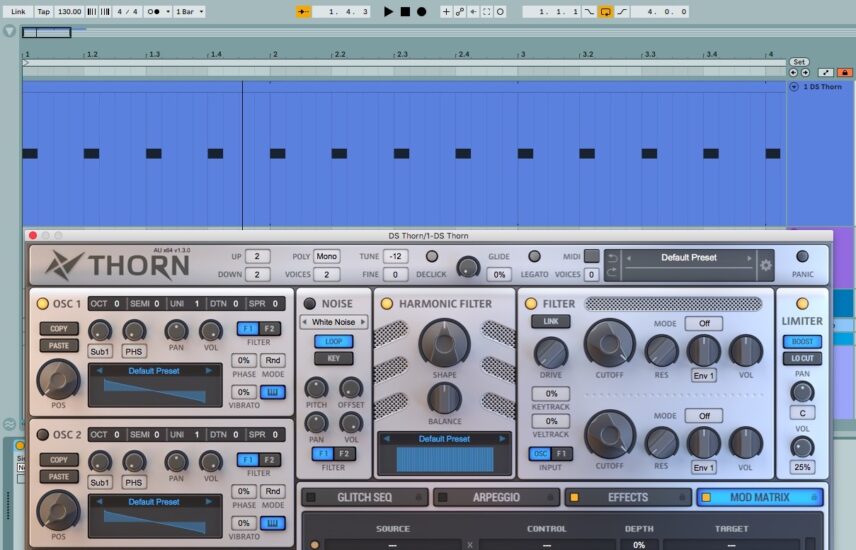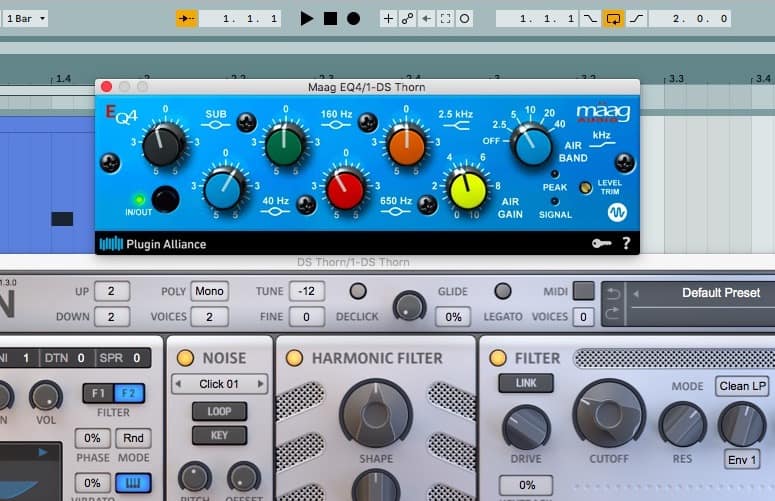
u-he are makers of award-winning software synthesisers and effects including Diva, Repro-1, Zebra2, Hive, Bazille, Presswerk and Satin.
Visit U-he

u-he are makers of award-winning software synthesisers and effects including Diva, Repro-1, Zebra2, Hive, Bazille, Presswerk and Satin.
Visit U-heIn this Synth Secrets, we’re going to use Thorn by DS Audio Alliance to make a kick drum from scratch. The article also comes with a free kick drum sample pack with the sounds all created using Thorn.
Kicks are a staple ingredient of dance music. Cooking them up from scratch means you can tweak them to fit your track, giving your productions an edge.
In this Synth Secrets, we talk you through the basic process of synthesising your own kick drums. At the end, there’s a free sample pack of kicks to download, all made using the techniques we describe.
Most producers use sampled kicks or drum machines. Both these options are quick and easy routes to getting a solid foundation to your tracks.
But if you want to go deeper into kick drum science, synthesising your own is a way to get some fresh kicks. It’s particularly helpful for tailoring a kick to fit into a track. You can dial in whatever you need, whether that’s something raw and distorted, a solid thump or a deep pulse. Compared to the usual 808 and 909 samples, rolling your own gives you more flexibility over the sound design.
Here’s the kick we’re going to make in this tutorial, mixed into a track for context:
To synthesise kicks, the main thing we need is a synth that can create a sine or triangle wave, with a separate envelope that can be set up to modulate the oscillator pitch.
Other useful features would be square waves, additional oscillators, noise and a filter. We’re going to use Thorn, a flexible softsynth that has everything we need. But you could adapt the techniques in this tutorial any software or hardware synth you have to hand, so long as it can modulate the pitch of an oscillator using an envelope.
Remember to click any image to enlarge!
We start by loading up Thorn in Ableton Live and adding notes in a 4/4 pattern. We’ve set the tempo to 130 BPM as a starting place for techno, and set the track to loop two bars.
Put Thorn in mono mode, and drop the tuning by an octave (minus 12 semitones) to get it into a low register for making kicks.

The core of our kick sound will be a sine wave oscillator. We set this up as follows:
It should now sound like a low boom:
You will hear some inconsistent clicks at the start of the hits. Don’t worry about that for now.
Now it’s time to add an envelope to modulate the pitch of the oscillator. We’ll use Thorn’s Env 2 for this purpose. Like the amp envelope settings, it needs zero Attack and Sustain, but with even shorter Decay and Release. This envelope will make the initial thump sound of the kick, so it needs to be fast.
Next we need to set this envelope to modulate the oscillator pitch. Thorn has a modulation matrix that is ideal for this purpose. In the top slot of the matrix, we set the source as Env 2 and the target as oscillator 1 pitch.
Then we set the sequence playing, and tweak the pitch modulation amount, envelope times and the oscillator pitch until we get a nice thump sound. Playing around with the different parameters can take some time to get a good result.
When adjusting things, notice how different amounts of pitch modulation and envelope times affect the sound. A small amount of pitch mod and longer release on the amp envelope will give a more 808 type smooth sound. Increasing the pitch modulation amount and decreasing the amp envelope times will give more of a 909 type thud. In Thorn, pitch modulation amounts of between 20-40% seem to give good results.
After some tweaking, here’s how our kick sounds:
We can now get creative by adding in further elements to this basic starting point. A bit of experimentation will generate different flavours. Every time you find something that sounds good, bounce down a sample and save it. This way, you can start to build up a collection of home made kicks.
Some things to try:
After some experimentation, we found a sweet spot with some drive on the main oscillator, and a click routed through a lowpass filter with fast envelope modulation. We also used a Maag EQ4 plugin to reduce sub and mid range clutter, and emphasise the main thump of the kick using the 40Hz band. A boost in the air band helped bring out the click of the attack.

Here’s how the finished kick sounds:
You might notice that the click of the attack varies slightly between different hits. This is because the start of each note lands at a different phase of the sine waveform. In a mix, this variation can give a subtle organic quality to a kick. But if you prefer strict consistency, just bounce to audio, cut out your favourite hit and use it as a sample.
To download the free sample pack, complete the form below. Please only input your details once! It will redirect to the homepage when it’s a successful submission.
Author Michael Gallagher
1st July, 2022

u-he are makers of award-winning software synthesisers and effects including Diva, Repro-1, Zebra2, Hive, Bazille, Presswerk and Satin.
Download the demos and try them for yourself at www.u-he.com
Attack Magazine is funded by advertising revenue. To help support our original content, please consider whitelisting Attack in your ad blocker software.
x